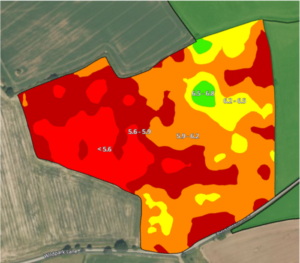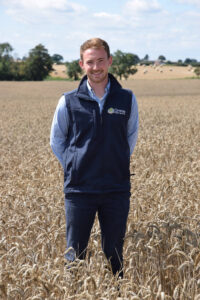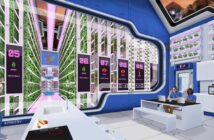A farm in Derbyshire has shared how it has have used technology to make savings on liming through variable rate applications.
Moodersley Farm in Kedleston, Derbyshire is an 80ha livestock farm run by the Greasley Family. Son Josh works as an agronomist for crop production specialists Hutchinsons and has been privy to the benefits of Terramap through his work with other clients in the area.
Terramap is a soil scanning service, available from Hutchinsons, that uses gamma-ray radiation technology to deliver resolutions of over 800 points/ha, providing high-definition mapping of all common nutrient properties, pH (e.g. % clay, % sand, % silt), soil texture, organic matter and CEC as well as elevation and plant available water.
The results from Terramap are used to create maps within the Omnia digital farming system which can then be overlaid with additional field information such as black-grass, yields and so on, to create the most accurate, consistent, and detailed variable rate plans.

pH layer from TerraMap
Soil mapping is widely used in the arable sector, but with rising demand for the technology from livestock farmers growing forage, more livestock farmers and contractors are now investing in it.
Mr Greasley said: “I wanted to trial Terramap on our own farm to see for myself what the cost-benefits would be of using the system on grassland, over our traditional soil sampling approach. I was hoping that by adopting variable rate applications of lime and only targeting areas that had a low pH, we could save enough money to cover the costs of the Terramapping and maybe if we were lucky even a bit more than that!
“For the trial. we chose a field that was just coming out of HLS that had received a small amount of lime and organic manure applied to it each year. We had the field soil sampled and followed up with Terramap. The results showed varied pH indices across the field ranging from 5.6-6.5. These differences can arise for several reasons such as differences in soil types, past management practices etc.
“Using the results from Terramap allowed us to create variable application maps, with a view to standardizing the pH across the field to somewhere around 6.5, as the correct pH between 6-7 maximises nutrient uptake.”
Lime is important because it reduces acidity, helping to unlock nutrients such as phosphate and potash. By applying the lime variably, it is possible to target areas with low pH levels more precisely, bringing the entire field to an optimal pH range, whilst hopefully making cost savings.
Looking at how this played out in terms of costs, Mr Greasley was happy with the results: “Instead of all of the field receiving a blanket application of 5000kg/ha, by only applying the lime where it was needed, we only used and average of 3050kg/ha, saving almost 2000kg/ha.
“With the costs of lime and spreading at £34/t, we saved 1.95t/ha, working out at an overall cost saving of £66/ha saving. At £29/ha for the standard Terramap service including OM measurement, the savings on lime have not only covered the costs of the mapping, but also saved on lime.”
 Mr Greasley continued: “We wanted to repeat the exercise in an arable context, so carried out a similar trial on a neighbouring farm, Buckhazels Farm owned by Mr Burton. The field had come out of wheat and was going into barley, so the field weas scanned in August, before the rape was drilled.
Mr Greasley continued: “We wanted to repeat the exercise in an arable context, so carried out a similar trial on a neighbouring farm, Buckhazels Farm owned by Mr Burton. The field had come out of wheat and was going into barley, so the field weas scanned in August, before the rape was drilled.
“Soil sampling of this field showed an average pH of 6.3. However, Terramap showed this ranged from 5.8 to as high as 8 in one corner. We were looking to raise the average of the field to 7, and to do this via a blanket approach would mean applying an additional 4900kg/ha. However, by adopting the variable rate maps created by Terramap and only applying the lime to the areas of the fields where it was needed, only 3840kg/ha was needed, saving 1060kg/ha.
“With lime and spreading costs at £34/t, a saving of £35/ha was made. With a standard Terramap scanning costing £25/ha, once again Terramap paid for itself and more.”
Mr Greasley said creating and using variable application maps in Omnia has been very simple, and although some time is needed to first set things up, once done, it is very quick and easy to adjust maps for individual fields or seasons.




